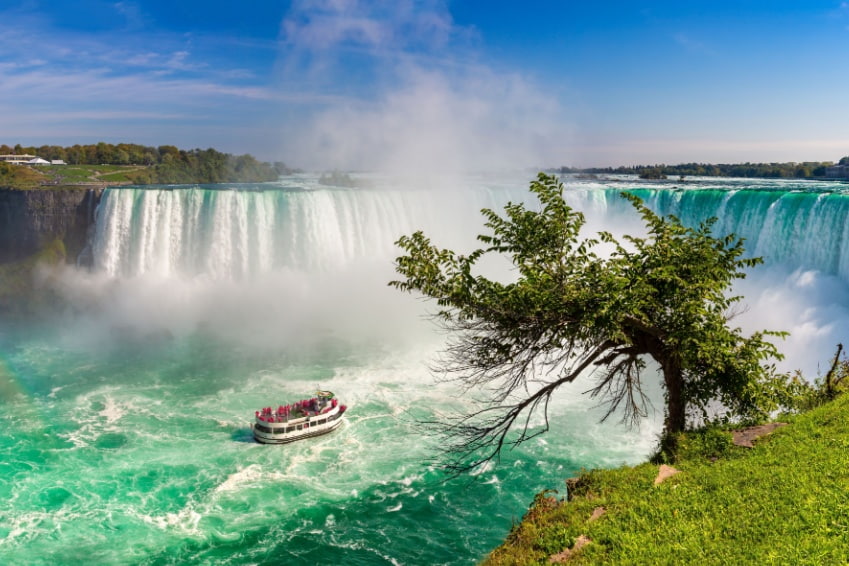
Did you know Niagara Falls has been slowly creeping backwards for 12,000 years? Or that it helped change the world’s electricity forever? We’ve rounded up 20 of the most fun, fascinating and downright mysterious facts about Niagara Falls that go beyond the usual tourist trivia.
Table of Contents
10 Fun and Interesting Facts About Niagara Falls
Niagara Falls is more than just a tourist attraction. This mighty natural phenomenon has helped shape the land, create the gorge and power whole cities (literally — more on that below). Let’s kick things off with 10 of the most overall interesting facts about Niagara Falls. These facts are related to nature, history and general interesting-ness. This is the stuff that makes everyone stop and say, “Wait, really?”
1. Niagara Falls is not just one waterfall
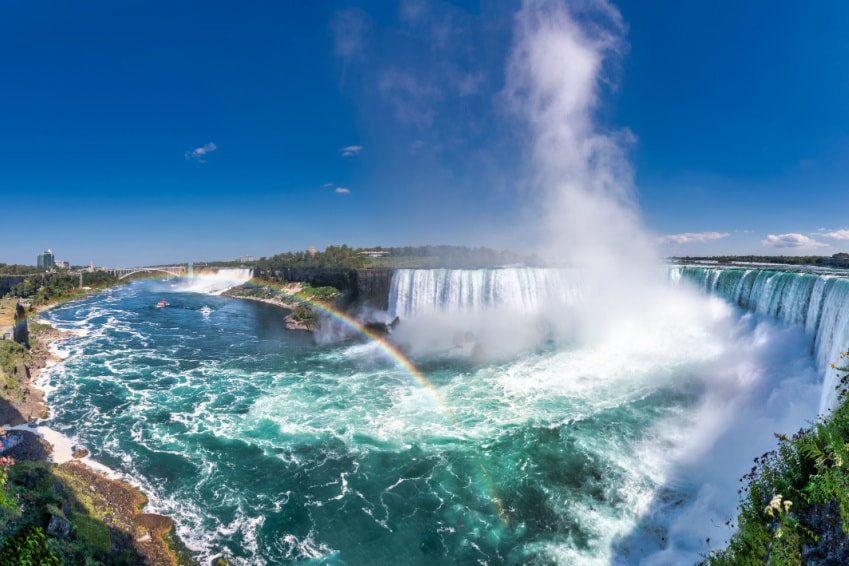
That’s right — you’re not looking at just one waterfall. Niagara Falls actually consists of THREE waterfalls. Wait, really?? (Told you!) They’re called Horseshoe Falls, American Falls, and Bridal Veil Falls. Together, they form one of the most awe-inspiring natural sights in the world.
2. The falls could fill an Olympic swimming pool in less than a second
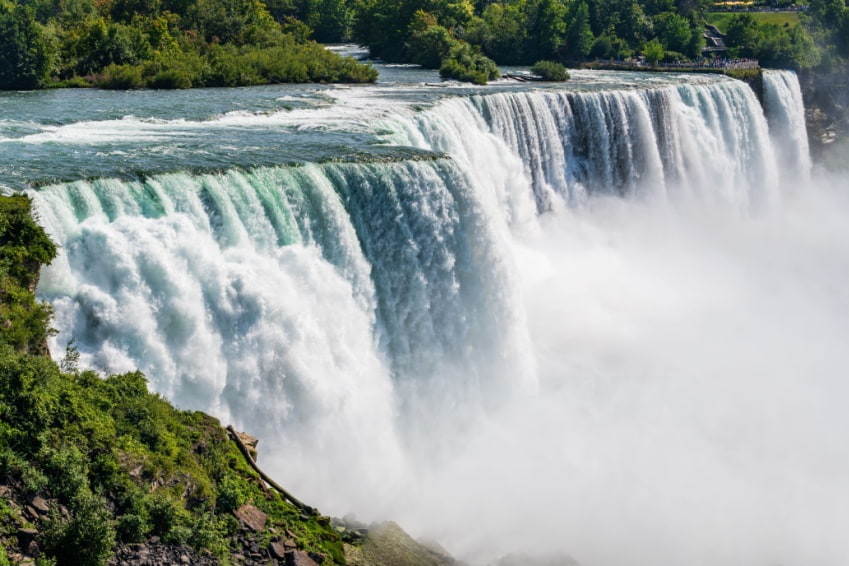
The water flows at about 85,000 cubic feet per second. That’s not just a lot of water; it’s an overwhelming, powerful, nonstop rush that has shaped the surrounding land and powered cities. In fact, it’s roughly 3,160 tonnes per second. 90% of the total water flow is carried by the largest of the falls, the colossal Horseshoe.
3. Niagara Falls once stopped
With all that water, you’d think that the Niagara Falls were an unstoppable force, but incredibly, they once stopped completely. During a particularly cold winter in 1848, an ice jam upstream blocked the flow and caused the falls to dry up.
Thousands descended on the site for the once-in-a-lifetime opportunity to walk, dance and even ride horse-drawn carriages along the dry riverbed. Some terrified locals feared the apocalypse. But luckily, about 30 hours later, the winds shifted, and the ice jam broke apart.
4. The falls have moved over 7 miles in 12,000 years
On to another of our incredibly interesting facts about Niagara Falls, and this one is a blinder… The falls are gradually inching upstream toward Lake Erie. The incredible force of the water flow causes ongoing erosion, which has moved the falls about 7 miles (11 km) upstream over 12,000 years. Engineers have since stabilised the falls to slow this movement, but the power of water is always at work…
5. Maid of the Mist boats are older than Canada itself
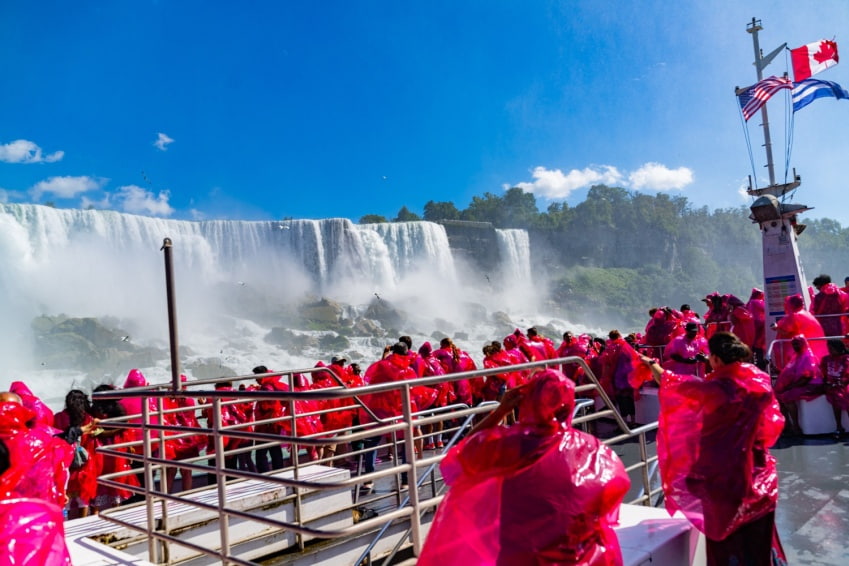
The Maid of the Mist started being tossed about below Niagara Falls in 1846. This was before Canada even became a country (in 1867). The beloved boat service started out as a ferry but quickly turned into a full-blown tourist experience. Everyone has ridden this humble boat, from presidents to royalty, including Theodore Roosevelt, Princess Diana, and the future King Edward VII.
And who was this mysterious Maid of the Mist? In Indigenous legend, there was a tragic young woman who, forced into a ceremonial sacrifice, was sent over the falls in a canoe. The Thunder God caught her and took her to his underwater realm. Some say her spirit still watches over the falls.
6. Niagara Falls have the power to create its own weather
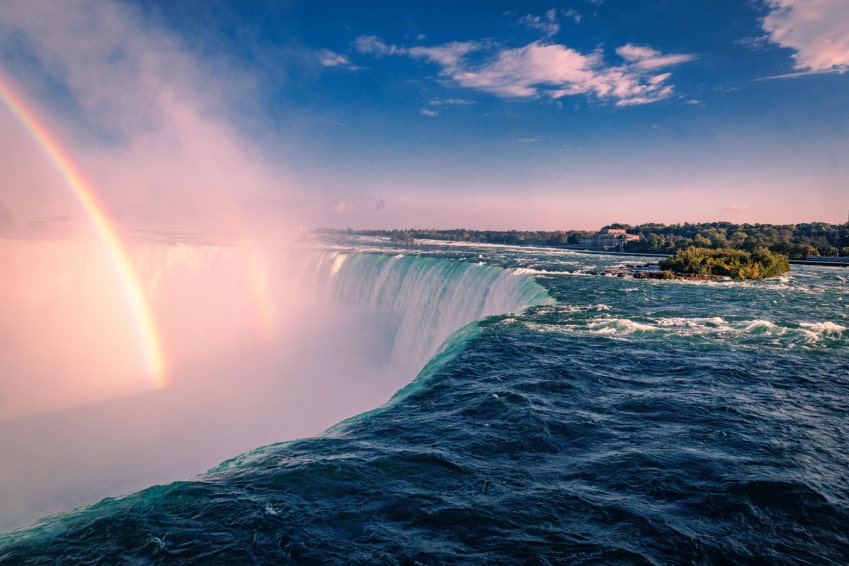
Yes, the falls are so massive and powerful that they affect local atmospheric conditions in some surprising ways. The constant spray and mist add moisture to the air, leading to increased humidity, localised fog, mini rain showers and some seriously stunning rainbows. In other words, its own microclimate. Sometimes, even lunar rainbows, or moonbows, appear when the moon is full. These ghostly, nighttime rainbows appear silver instead of colourful.
7. The falls partially freeze in winter
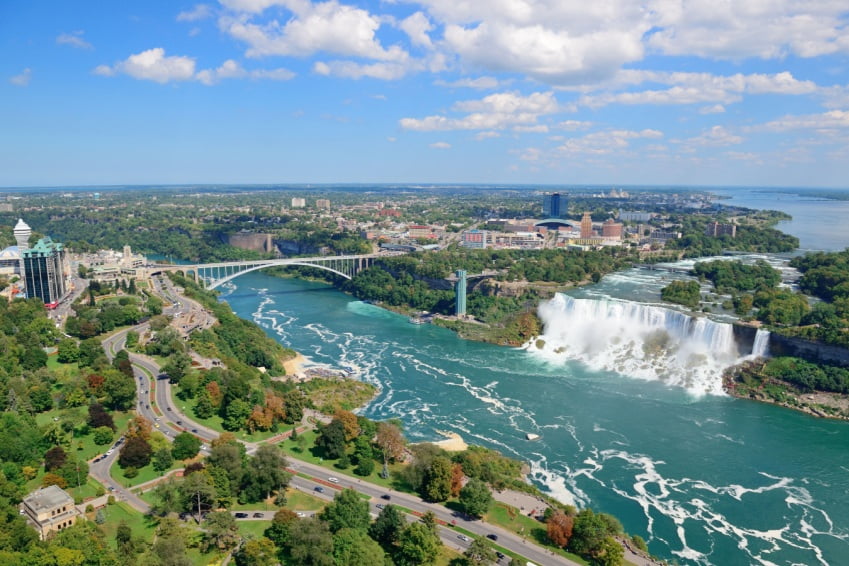
One of the most magical and surprising facts about Niagara Falls is that it can partially freeze in winter. No, it doesn’t completely freeze (there’s just too much water moving too fast). But the surrounding mist and spray create enormous ice formations, snow-covered boulders and glittering icicles that turn the area into a surreal, frozen wonderland. Bring a camera, some warm gloves and a cup of cocoa!
In especially cold winters, ice can spread across the river, forming an “ice bridge”.
In the 1800s and early 1900s, people would actually walk — and even set up stalls — on the frozen river. After a tragic collapse in 1912 that killed several visitors, walking on the ice was banned for good.
8. The rocks beneath the falls are older than dinosaurs
Niagara Falls might be 12,000 years old, but the rocks it’s crashing onto? Nearly half a billion years old. That’s not just ancient; that’s prehistoric sea-monster ancient. The base of Niagara Falls is actually the fossilised floor of an ancient ocean that was teeming with marine life like trilobites, coral and brachiopods. Today, you can see fossilised marine creatures, remnants from when this area was a tropical seabed.
9. There’s a hidden cave behind Horseshoe Falls
Can you believe we’re already at number 9 in our list of the top facts about Niagara Falls? And it’s this – there’s a secret cave behind Niagara Falls. You can actually stand behind the roaring curtain of water and feel the thunder shaking through the rock. While often called a “cave”, it is actually a series of man-made tunnels leading to observation portals and a deck near the base of the falls. In the early 1800s, there was a natural cavern behind the American Falls (not Horseshoe), but, sadly, it collapsed in 1954.
10. The name “Niagara” means “Thunder of Waters”
It comes from the Iroquoian word “Onguiaahra”, often translated as “The Strait” or “Thunder of Waters”. Either way, it’s a pretty accurate description.
5 Cool Facts About Niagara Falls
Tech fans, pop culture lovers, and thrill-seekers — this one’s for you.
11. The falls light up every night
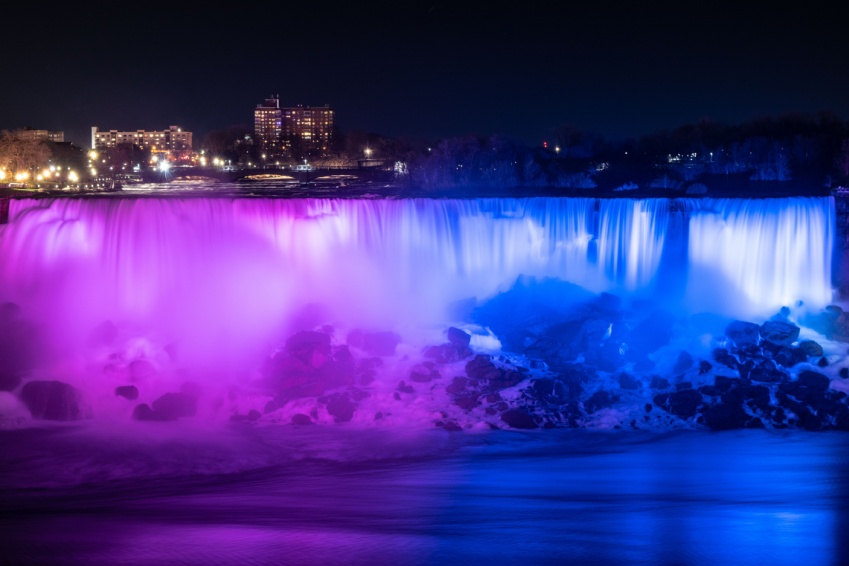
Every single evening, Niagara Falls is illuminated with colourful LED lights, transforming the rushing water into a glowing cascade. It’s especially magical when paired with the nightly fireworks show in summer.
12. Electricity was born here
In 1895, Nikola Tesla and George Westinghouse created the world’s first hydroelectric power plant right here at Niagara Falls. Their success helped prove AC power could light up cities — and this moment revolutionised how the entire world uses electricity. That same hydropower legacy continues today — the falls generate enough electricity for nearly 4 million homes in the U.S. and Canada.
13. Niagara Falls is a movie star
From Superman II to Bruce Almighty and even Pirates of the Caribbean, Niagara Falls has shown up in dozens of films and programmes. The mist, the drama, the sheer scale — Hollywood just can’t resist.
14. The Rainbow Bridge connects Canada and the U.S.

The aptly named Rainbow Bridge lets you walk, cycle or drive right across the border — with epic views of the falls the whole way. Don’t forget your passport! The unique bridge opened in 1941, after the previous Honeymoon Bridge collapsed in the ice jam. The collapse was dramatic, but thankfully no one was hurt. The Rainbow Bridge was built slightly upstream and designed to withstand future icy assaults.
15. You can fly over the falls
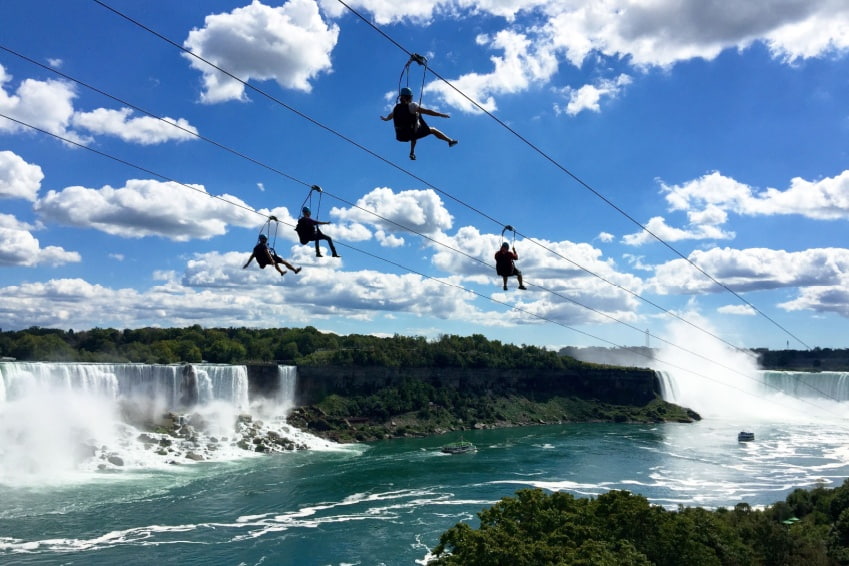
You can view Niagara Falls by boat, helicopter, observation decks, cable car, Ferris wheel, or even by zipline toward the falls from the Canadian side – mist, rainbows and adrenaline guaranteed. Basically, however you want to experience the falls, there’s an option.
5 Mysterious Facts About Niagara Falls
16. Many daredevils have attempted to go over the falls in barrels
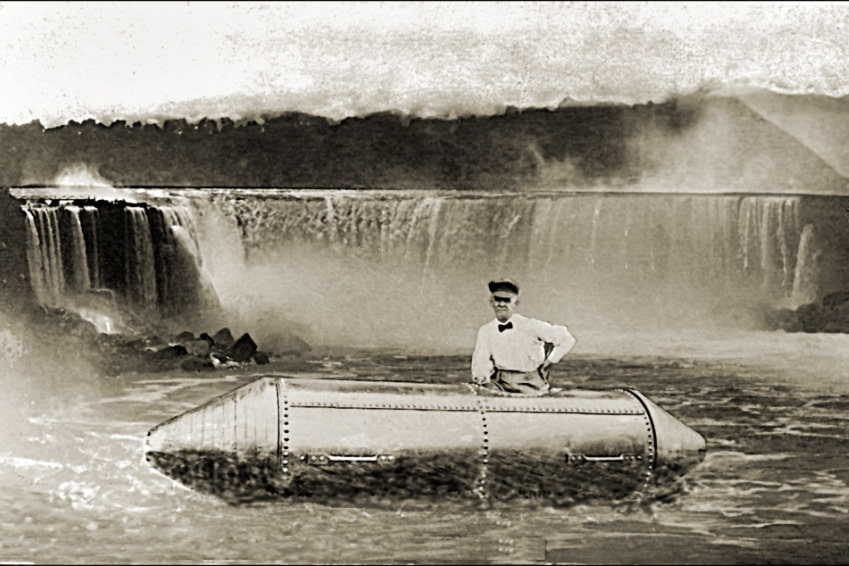
It sounds like something out of a cartoon, but it’s one of the most daring (and frankly bonkers) chapters in Niagara Falls history. In 1901, on her 63rd birthday, Annie Edson Taylor became the first person to go over Niagara Falls in a barrel — and survive. Her barrel was made of oak and padded with a mattress. When rescuers found her, she was bruised but alive. Her advice afterwards? “No one ought ever do that again.” (Spoiler: plenty of people did.)
Over the years, many thrill-seekers have tried to go over the falls in barrels, jet skis, kayaks, rubber balls and even homemade submarines. Some survived. Many did not. Since 1951, 50 years after Annie Edson’s untimely death, this peculiar practice has been banned.
17. There have been several fatal accidents at the falls
Sadly, the falls have seen accidental tragedies too. On average, 20 to 30 people die at Niagara Falls each year, though the numbers fluctuate. Many of these deaths are accidental, some are suicide attempts, and a small number involve daredevils attempting dangerous stunts.
There are happier stories too: in a rare and incredible twist, a 7-year-old boy named Roger Woodward was swept over Horseshoe Falls in 1960 — without any safety device. He had been in a boat with his sister and family friend when the motor failed. The friend died, but Roger survived the 188-foot plunge wearing only a life jacket. His rescue from the river is considered one of the most miraculous in Niagara history.
18. The whirlpool below the falls is extremely dangerous and powerful
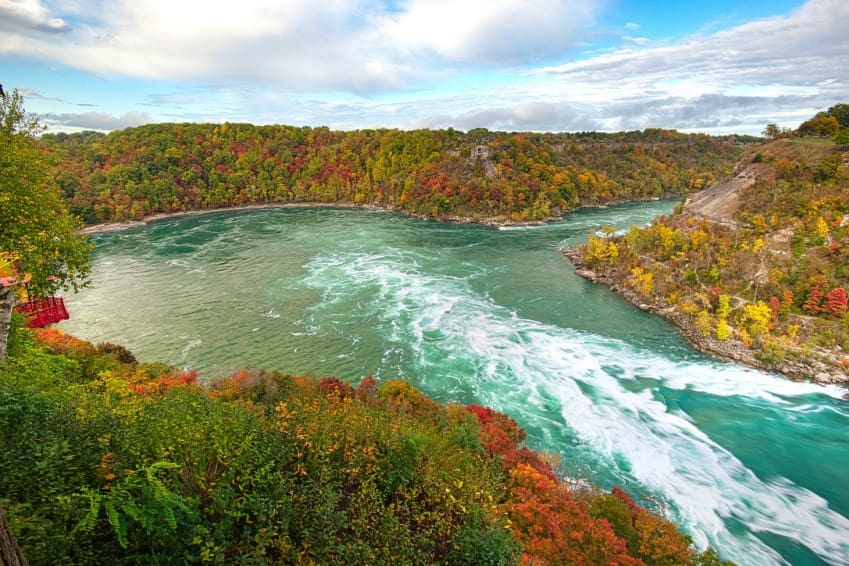
Below the falls lies a massive whirlpool with currents so powerful they can trap anything: debris, small boats, and even bodies. The currents are so strong that rescue is nearly impossible once something enters the vortex. Some victims have vanished without a trace, never recovered from the depths.
Want to know a cool “twist”? The direction of the whirlpool’s spin changes. Depending on the volume of water being diverted for hydroelectric power, the flow of the river can be altered. Normally, it spins anticlockwise, but under certain conditions it can reverse and spin clockwise. Science!
19. Human remains were found beneath the Niagara Falls power station
When excavating the Canadian power station, workers reportedly found human remains and burial artefacts — possibly from early Indigenous settlements or early European settlers. Some say the station is still haunted by the spirits of those disturbed.
20. The falls could be haunted
Beneath all the roaring water and rainbow-filled mist lies a hidden world of caves and tunnels. Some are sealed off and haven’t been entered in decades, leading to local legends of hidden passageways, forgotten machinery and ghosts, from lost workers during early tunnel construction to mysterious sounds and sightings in abandoned shafts.
And some visitors have claimed to hear eerie screams rising from the mist — especially around Horseshoe Falls, although this could simply be the roaring water echoing off the rocks. While there’s no solid proof, it definitely adds an air of mystery to the underground world.
More Than Just a Waterfall: The Many Faces of Niagara Falls
There you have it — 20 fun, cool, and mysterious facts about Niagara Falls. Whether you’re visiting for the views, the excitement or the centuries of history, there’s always something new to discover.
Want to see it all in one go? Book your Niagara Falls Day Tour Ticket and experience the magic for yourself on our City Sightseeing Niagara Falls Day Tour.
Happy travels!
Like? Share this post with your friends
Frequently Asked Questions
Around 12,000 years old, formed at the end of the last Ice Age.
Absolutely not. The currents are extremely dangerous, even miles downstream.
The volume and speed of water — over 3,000 tons every second — make it one of the most powerful waterfalls in the world.
Nope. That title goes to Yosemite Falls in California. Niagara is more about power and width than height.
They partially freeze, forming magical ice sculptures, but the water still flows underneath.
